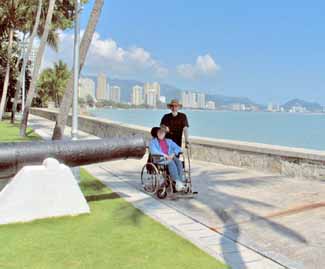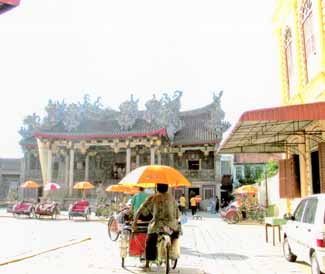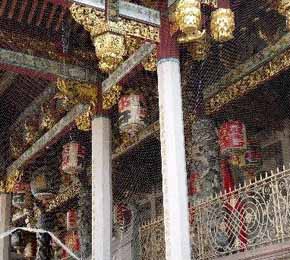One of the nice things about cruising is that you are exposed to a great number of different cultures and countries within a short period of time. One of the not-so-nice things about
cruising is that the time allowed in each port barely gives you any understanding of the culture and the country you are visiting. Just enough time to maybe reach a decision whether this is a place you
want to come back to see another time at your leisure.
When a ship docks, there is usually a lineup of taxis waiting to whisk passengers away for tours. Here in Georgetown (Penang) Malaysia, we were met by the more common mode of transport, the Malaysian Trishaw, a most relaxed, low speed means of getting around the city.
Malaysia once belonged to a sultan, but was bought from him in 1786 by an agent on behalf on the famed British East India Company.
During
the period of colonial occupation, the British built a beautiful city, Georgetown, with wide boulevards, glorious parks and spacious houses.You can get a brief idea of what the city is like from this photo, taken along the seawall.

We are at Fort Cornwallis, the oldest English structure in town. The cannon, not really pointing at us, is the Seri Rambai, known as the "Roving Cannon". It gets this name from its history: Originally owned by Dutch merchants, it was passed to the Sultan of Jahare, then to Portuguese colonists, and finally to pirates before coming to the fort in the early 1600's. Legend has it that it has magical powers to grant women pregnancy if they place flowers into the barrel.
On a delightful trishaw ride around Georgetown, we visited temples, museums and toured past government buildings erected by the British during the period of their governance
in Malaysia. They lived well, the British, as is obvious from the wide boulevards and gracious buildings they constructed.
Some of the wealthier non-British residents did not do too badly, either. There has been a sizable migration from China, and this influence is seen everywhere. For example:

Shown in this (poor) photo is the main temple, built by the Khoo Kongsi, a clan originally from China. The Khoo Family still exists today, and new members are always welcome here.

The photo above is of the entrance of the Khoo Kongsi Temple. The temple is only a part of an entire village for this one clan within the city. Not exactly ancient, it was constructed in the early 1900's by the members of the clan who were traders and merchants.
Not constructed with the wheelchair visitor in mind, we had to hire a few local youngsters to carry Nan up a set of stairs. They stayed with us through the temple, lifting her over doorways and other difficult passageways.
There is an enticing flavor of the blending of East and West here. It is exotic, but inviting, rather than off putting. We had a good time.
***********************************
The Malaysians are a spirited people, with positive attitude and pleasing manners, assuring themselves of pleasant times ahead. The same is true of visitors. We would like to return sometime and explore it leisurely. |
